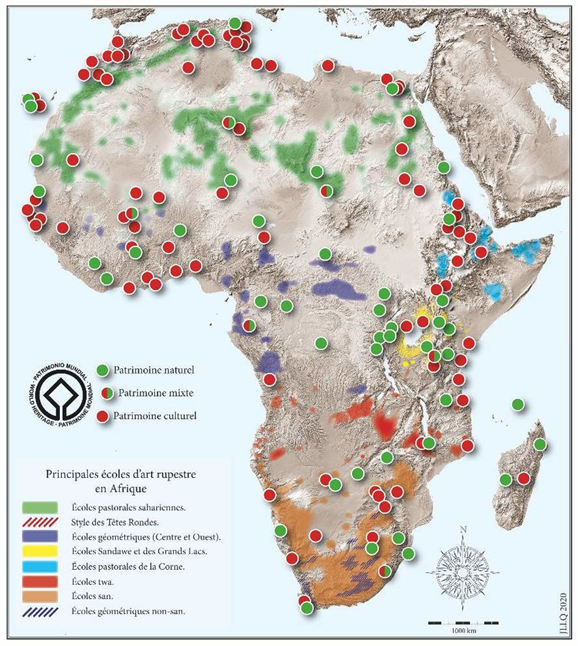Africa is the “cradle of humanity” and, perhaps, the cradle of the emergence of symbolic thought in modern man. The continent is home to approximately 200,000 prehistoric sites, caves, and rock shelters; it is the richest on the planet in this area. Some of the oldest artistic representations, such as decorative objects and abstract engravings, markers of symbolic thought, have been found there.
In the early 2000s, ornamental beads made of Nassarius shells were discovered in the Blombos cave in South Africa, dating back 72,000 to 75,000 years. Additionally, engraved ochre plaques found at the site are estimated to be around 100,000 years old. These discoveries rank among the oldest artistic representations in the world, along with those of Oued Djebbana in Algeria, which also contained ornamental beads dating back 100,000 years, and those of the Pigeon Cave in Taforalt, Morocco, which yielded Nassarius gibbosulus beads dating back 82,000 years.
This tends to push back the date of the emergence of artistic artifacts by at least thirty millennia. For a long time, it was accepted that the oldest adornments, then dated around 40,000 years old, came from Europe and the Near East. However, ever since the discovery of adornments and 75,000-year-old engraved ochres in South Africa, this idea has been called into question.
Ancient Egypt, a powerful and enduring civilization in which religion occupied an important place, produced numerous works. Many of which represented divinities or pharaohs, in the form of paintings, bas-reliefs, high reliefs, sculptures, decorated pottery, metal jewelry, etc. Writing appeared there around 3200 BC. Egyptian literature, made up of religious and secular texts, is among the oldest known, attested from 2700 BC by complex texts on papyrus. Architecture is also a major witness to Egyptian art, especially the art of the pyramids which gave it a universal reputation. The Pyramid of Cheops (around 2560 BC), one of the Seven Wonders of the Ancient World, is the only one to have survived; it was the tallest human construction for 4,000 years.
North Africa, under the influence of the Mediterranean area and later of Islam from the 7th century, is home to the art of late Antiquity—with, for example, the archaeological site of Carthage—(Punic, Roman, Vandal, early Christian, and Arab periods) and then Muslim art, with the Great Mosque of Kairouan in Tunisia, built in 670, which is one of its symbols. In the Islamized part of sub-Saharan Africa, Muslim art coexists with indigenous art.
Sub-Saharan Africa yields artifacts characteristic of the cultures (in the archaeological sense of the term) that have populated it over time. These objects are first and foremost historical objects; the absence of indigenous written sources on ancient Africa south of the Sahara means that they are almost the only witnesses to the past; even the buildings are often absent—we still do not know for sure where the capital of the Mali Empire (12th–15th century) was, hence the interest in the ruins of Great Zimbabwe—and the written sources, Arab-Muslim, do not deal with the subject of art. These historically precious artifacts also acquired, in the 20th century, the status of works of art, which earned them a prominent place in museums, on the current international market, and also generated a flourishing illicit trade.
Left: Situation of sites classified as natural heritage. Right: Sites classified as cultural heritage. Densities are represented according to the principle of heat maps, ranging from the warmest colors for the highest densities to the coldest colors for the lowest densities. The comparison highlights a strong contrast in the density of the two types of sites considered.
For more information :
- https://fr.wikipedia.org/wiki/Portail:Afrique
- https://en.wikipedia.org/wiki/Africa
- https://africacenter.org/
- https://journals.openedition.org/etudesafricaines/
- https://etudes-africaines.cnrs.fr/
- https://journals.openedition.org/etudesafricaines/
- https://www.afdb.org/fr/documents-publications/economic-perspectives-en-afrique-2024




